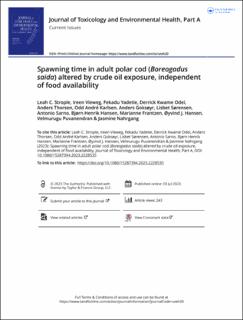| dc.contributor.author | Strople, Leah Catherine | |
| dc.contributor.author | Vieweg, Ireen | |
| dc.contributor.author | Yadetie, Fekadu | |
| dc.contributor.author | Odei, Derrick Kwame | |
| dc.contributor.author | Thorsen, Anders | |
| dc.contributor.author | Karlsen, Odd André | |
| dc.contributor.author | Goksøyr, Anders | |
| dc.contributor.author | Sørensen, Lisbet | |
| dc.contributor.author | Sarno, Antonio | |
| dc.contributor.author | Hansen, Bjørn Henrik | |
| dc.contributor.author | Frantzen, marianne | |
| dc.contributor.author | Hansen, Øyvind J | |
| dc.contributor.author | Puvanendran, Velmurugu | |
| dc.contributor.author | Nahrgang, Jasmine | |
| dc.date.accessioned | 2023-08-14T12:12:45Z | |
| dc.date.available | 2023-08-14T12:12:45Z | |
| dc.date.created | 2023-07-25T13:59:44Z | |
| dc.date.issued | 2023 | |
| dc.identifier.issn | 1528-7394 | |
| dc.identifier.uri | https://hdl.handle.net/11250/3083869 | |
| dc.description.abstract | Fish early life stages are well known for their sensitivity to crude oil exposure. However, the effect of crude oil exposure on adults and their gametes during their spawning period is not well studied. Polar cod, a key arctic fish, may be at risk for crude oil exposure during this potentially sensitive life stage. Additionally, this species experiences lower food availability during their spawning season, with unknown combined consequences. In the present study, wild-caught polar cod were exposed to decreasing levels of a water-soluble fraction (WSF) of crude oil or control conditions and fed either at a low or high feed ration to assess the combined effect of both stressors. Samples were taken during late gonadal development, during active spawning (spawning window), and in the post-spawning period. Histology analysis of gonads from fish sampled during the spawning window showed that oil-exposed polar cod were more likely to have spawned compared to controls. Oil-exposed females had 947 differentially regulated hepatic genes, and their eggs had a higher polycyclic aromatic hydrocarbon body burden compared to controls. Feed ration did not consistently affect polar cod’s response to oil exposure for the endpoints measured, however, did alone result in decreases in some sperm motility parameters. These results suggest that polar cod’s spawning period is a sensitive life event to crude oil exposure, while feed limitation may play a minor role for this supposedly capital breeder. The effects of adult exposure to crude oil on gamete quality and the next generation warrant further investigation. | en_US |
| dc.language.iso | eng | en_US |
| dc.publisher | Taylor & Francis | en_US |
| dc.rights | Navngivelse 4.0 Internasjonal | * |
| dc.rights.uri | http://creativecommons.org/licenses/by/4.0/deed.no | * |
| dc.title | Spawning time in adult polar cod (Boreogadus saida) altered by crude oil exposure, independent of food availability | en_US |
| dc.type | Journal article | en_US |
| dc.type | Peer reviewed | en_US |
| dc.description.version | publishedVersion | en_US |
| dc.rights.holder | Copyright 2023 The Author(s) | en_US |
| cristin.ispublished | true | |
| cristin.fulltext | original | |
| cristin.qualitycode | 1 | |
| dc.identifier.doi | 10.1080/15287394.2023.2228535 | |
| dc.identifier.cristin | 2163497 | |
| dc.source.journal | Journal of Toxicology and Environmental Health, Part A | en_US |
| dc.identifier.citation | Journal of Toxicology and Environmental Health, Part A. 2023. | en_US |

